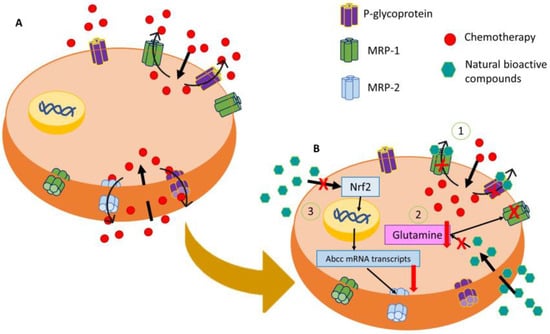Colorectal cancer is one of the leading causes of morbidity and mortality today. Knowledge of its pathogenesis has made it possible to advance the development of different therapeutic strategies. However, the appearance of drug resistance constitutes one of the main causes of treatment failure. Bioactive compounds of vegetable origin are being studied as a new strategy to improve antitumor treatment, due to their ability to regulate the pathways involved in the development of carcinogenesis or processes that are decisive in its evolution, including multidrug resistance. In vitro and in vivo studies of these substances in combination with cytotoxic drugs have shown that they reduce resistance and increase therapeutic efficacy. The objective of this review is to summarize the knowledge that is described in the scientific literature on the antitumor and chemo-sensitizing capacity of vegetable-derived biomolecules such as polyphenols, flavonoids, and terpenes. These compounds may hold a promising future in improving the treatment of colorectal cancer.
- vegetal compounds
- colorectal cancer
- cancer
- vegetal extracts
- cancer treatment
- systematic review
1
2. Colorectal Cancer: Resistant Mechanisms

2. Antitumor Potential of Natural Products for Colorectal Cancer
| Fam. | Comp. | Sinergy | In Vitro | In Vivo | Clinical Trials | Refs. |
|---|---|---|---|---|---|---|
| Polyphenols | Resveratrol | 5-FU, OXA | Apoptosis and decreased AC (VEGF inhibition). IC50 of 10 mg/mL in HT-29 (72 h). | 150 or 300 ppm doses prevented cancerous lesions and induced apoptosis via BAX | Safe intake up to a 1g/day dose. Limited BAV (2–29%). | [23][24][25][26][27][28][29][30][31][20,47,49,50,52,54,55,57,58] |
| Curcumin | DOX, 5-FU, OXA | G1-CCA and apoptosis at 20 µM. Reduced cell migration and invasion. | 300 mg/kg dose prevented precancerous lesions and decreased tumor size. | Low absorption and BAV. Increased tumor apoptosis. | [21][32][33][38][39][69,70,71[34],72[35],73[36],74[37],75,76,81] | |
| Kaempferol | DOX, 5-FU, OXA | G1 and G2/M-CCA and apoptosis induction. Decreased AC at 0.1 µM in MDA cell line. | Decreased AC and MC. | Low toxicity and BAV (2%). | [22][40][41][42][43][44][45][46][47][82,83,84,85,86,87,88,89,90] | |
| Flavonoids | Quercetin | DOX | CCA, apoptosis and decreased AC and MC. CYT in up to 300 µM doses in HCT-15, RKO, CT26, MC38, and HT29 cells | 10 and 50 mg/kg reduced precancerous lesions and tumor size. Decreased MC and CHR. | Not performed. | [48][49][50][51][52][53][24[,9254,93,94],95,96,97] |
| EGCG | 5-FU, IRI, CPT, OXA | S and G2-CCA, apoptosis, CYT IC50 between 74.6 and 112.1 in CRC cell lines SW480, SW620, and LS411N. Decreased MC. | 30 mg/kg for 2 weeks decreased MC, tumor growth and induced apoptosis | 150 mg twice a day of green tea extract did not show any effect in CRC development risk | [55][56][[1857][58,99,100],101[59],102[60],103[61],104[62],105[63],106[64],107] | |
| Terpenes | Geraniol | 5-FU | S-CCA. CYT IC30 of 200 µM for 7 days treatment in Caco-2 cell line. | 250 mg/kg for 4 weeks prevented CRC precancerous lesions. Reduced tumor growth and apoptosis induction. | Not performed. | [65][66][67][116,117,118] |
| Panaxadiol | 5-FU, IRI | CYT IC50 lower than 10 µM in HCT116 cell line (72 h). Decreased AC (VEGF inhibition) | 30 mg/kg for 3 weeks reduced tumor growth and AC. | Not performed. | [68]][119[69],123[70][71,124,125] | |
| Rg3 | 5-FU | CYT IC50 100–200 µM in HT-29 cell line (48 h). Induction of apoptosis and AC via AMPK dysregulation. | 25 mg/kg for 12 days reduced tumor vascularization and decreased CHR to 5-FU and OXA. | Not performed. | [71][72][73][121,122,125] |
